Click on images to enlarge

a plant which has "jumped the garden fence" (Photo: Mellisa Offord)
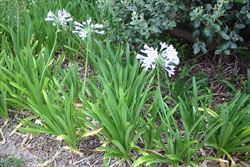
growing in a massed garden planting (Photo: Sheldon Navie)
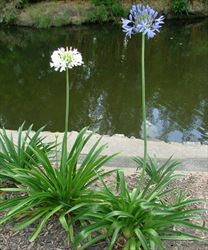
habit of blue and white flowered forms (Photo: Sheldon Navie)

leaves and flowering stems (Photo: Sheldon Navie)
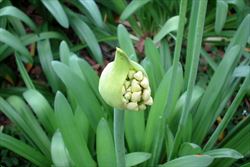
young flower cluster with flower buds partially enclosed in two leafy bracts (Photo: Sheldon Navie)
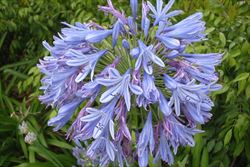
flower cluster (Photo: Sheldon Navie)
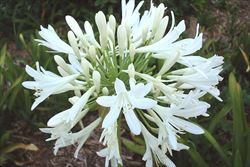
flower cluster (Photo: Sheldon Navie)
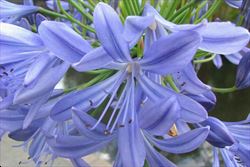
close-up of blue flowers (Photo: Sheldon Navie)

close-up of white flowers (Photo: Sheldon Navie)
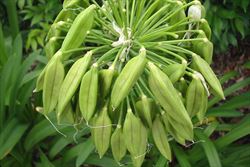
immature fruit (Photo: Sheldon Navie)
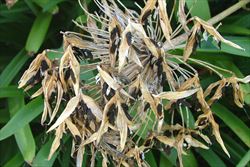
mature fruit (Photo: Sheldon Navie)
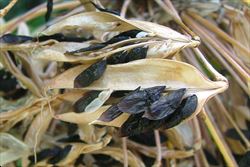
close-up of winged black seeds (Photo: Sheldon Navie)

Agapanthus praecox subsp. minimus in cultivation (Photo: Sheldon Navie)
Scientific Name
Agapanthus praecox Willd. subsp. orientalis (F.M. Leight.) F.M. Leight.
Synonyms
Agapanthus orientalis F.M. Leight.
Family
Alliaceae (Queensland, New South Wales, the ACT, Western Australia)Liliaceae (Victoria, Tasmania and South Australia)
Common Names
African lily, agapanthus, common agapanthus, lily of the Nile
Origin
Native to southern Africa (i.e. Cape Province and Natal in South Africa).
Cultivation
Agapanthus (Agapanthus praecox subsp. orientalis) is widely cultivated as a garden plant in eastern and southern Australia, and has also been widely grown in roadside and amenity plantings in these regions. Numerous different cultivars are also grown in Australia, including some dwarf forms and others with variegated leaves (e.g. Agapanthus praecox 'Variegatus' and Agapanthus praecox 'Aureovittatus').
Other subspecies of agapanthus (i.e. Agapanthus praecox subsp. minimus and Agapanthus praecox subsp. praecox) may also be seen in cultivation.
Naturalised Distribution
Agapanthus (Agapanthus praecox subsp. orientalis) has become naturalised relatively recently in the temperate regions of southern Australia. It is already well established in south-western Western Australia (i.e. near Denmark, Albany and in the Porongorups), on the central tablelands of New South Wales (i.e. particularly in the Katoomba area of the Blue Mountains), on Lord Howe Island, and in some parts of Victoria (i.e. mainly in coastal districts). It is also questionably established around Adelaide in south-eastern South Australia and has been reported in several parts of Tasmania (though this has not yet been confirmed by herbarium records).
Also naturalised in other parts of the world, including New Zealand, Great Britain and the Canary Islands.
Note: The other subspecies of agapanthus (i.e. Agapanthus praecox subsp. praecox) has also been recorded as naturalised in Western Australia.
Habitat
Persists in old gardens and becomes naturalised along roadsides, in rail reserves and in other disturbed areas. It can spread from such areas to invade urban bushland, forest margins, waterways and pastures. Also grows in sandy coastal sites in Victoria, on exposed sandstone cliff ledges in New South Wales, and on the lower slopes of karri/tingle forest in Western Australia.
Habit
A large and long-lived (i.e. perennial) herbaceous plant growing up to 1 m tall. It forms dense clumps via short underground stems (i.e. it is rhizomatous) and has a tuberous root system.
Distinguishing Features
- a large herbaceous plant that forms dense clumps and has a tuberous root system.
- its very large strap-like leaves are produced in clusters at the base of the plant and are somewhat leathery in nature.
- its long flowering stems (60-120 cm tall) bear a large cluster of flowers at their tips.
- these flowers are blue, or occasionally white, with six large 'petals' that are fused into a tube at the base.
- its fruit is a relatively large and somewhat elongated three-sided capsule.
Seedling
Stems and Leaves
This species does not have any aboveground stems, except for the long flowering stalks. These are green, round in cross-section (i.e. terete) and hairless (i.e. glabrous). They are quite thick and have hollow centres.
The very large and strap-shaped (i.e. linear) leaves are produced in clusters (of up to 20 leaves) at the base of the plant (i.e. they are basal). These glossy leaves (20-70 cm long and 3-5 cm wide) are relatively thick and somewhat fleshy or leathery in nature, with veins running lengthwise (i.e. parrallel veins). They are stalkless (i.e. sessile), but have a short sheath at their bases. Their margins are entire and they are hairless (i.e. glabrous).
Flowers and Fruit
The flowering stems bear a single large, dense, and almost spherical cluster of numerous (i.e. up to 100) flowers at their tips(i.e. a terminal umbel). These flowers are initially enclosed in two thin leafy bracts, which are shed as the flowers begin to open. Each of the bright blue to mauve (or occasionally white) flowers is borne on a long spreading stalk (i.e. pedicel) 9-12 cm long. They have six large 'petals' (i.e. perianth segments or tepals) that are 40-45 mm long and 6-11 mm wide. These 'petals' are fused into a tube (15-20 mm long) at the base. The flowers also have six stamens, consisting of long filaments tipped with anthers that are yellow at first and become darker with age. These stamens surround a single long style that is tipped with a globular (i.e. capitate) stigma. Flowering occurs mostly during summer (i.e. from November to February).
The fruit is a relatively large and somewhat elongated three-sided capsule (about 50 mm long). These fruit turn from green to pale brown or straw-coloured as they mature, and split open to release their numerous (20-100) seeds. These seeds are black, flattened, and have a wing-like projection.
Reproduction and Dispersal
This species reproduces via large numbers of tiny seeds. It can also reproduce vegetatively via its short creeping stems (i.e. rhizomes).
The light seeds may be spread by the wind or in water (e.g. they are often washed into stormwater drains and waterways). Clumps can spread laterally via their creeping underground stems (i.e. rhizomes) and can give rise to new individuals. However, clumps are most commonly spread to natural areas in dumped garden waste and in contaminated soil (seeds may also be spread in this way too).
Environmental Impact
Agapanthus (Agapanthus praecox subsp. orientalis) is regarded as a significant environmental weed in Victoria and is also deemed to be an environmental weed or potential environmental weed in New South Wales, Tasmania, South Australia and Western Australia. It is a very popular and hardy garden plant that is beginning to cause significant weed problems. Many infestations have probably become established from dumped garden rubbish, but it also spreads quickly down drainage lines. Its dense clumping roots are capable of displacing other ground-dwelling plant species and it may also prevent the regeneration of trees and shrubs. Hence it is considered to have an enormous potential to change plant ecosystems and even eliminate habitat for native fauna. It is a relatively fire retardant species and may therefore have an impact on the fire regimes in invaded areas (i.e. it may reduce fire frequency and or intensity). Though numerous local government authorities and community groups have published their concern regarding this species, there are relatively few herbarium records of it becoming naturalised in natural areas. Its naturalised distribution is probably significantly under-represented because good specimens are unwieldy to handle and difficult to preserve.
In Victoria, agapanthus (Agapanthus praecox subsp. orientalis) is regarded as being a serious threat to one or more vegetation formations. In this state it has spread widely along foreshores and other coastal sites, particularly around urban areas, and also threatens native vegetation along waterways in some areas. Some of the regions and locations where it is listed as being weedy include Monash City, Knox City, Banyule City, the greater Melbourne region, Yarra Ranges Shire, the Glen Fern Valley Bushlands, Kananook Creek, Baw Baw Shire, the Geelong region, Surf Coast Shire, Moyne Shire, the Angahook-Otways region, and the Glenelg-Hopkins and Corangamite regions.
Agapanthus (Agapanthus praecox subsp. orientalis) is probably causing most concern in the world heritage listed Blue Mountains National Park on the central tablelands of New South Wales. In particular, a relatively large infestation of this species is present on the ledges on the cliff below the Echo Point lookout, near the Three Sisters. This infestation is thought to have spread from garden plantings above the lookout. Agapanthus (Agapanthus praecox subsp. orientalis) has also become naturalised in other parts of the Blue Mountains, particularly around Katoomba, and is also a concern in other areas in the wider Sydney and Blue Mountains region (i.e. in Warringbah and other parts of North Sydney and on the Cumberland Plain in western Sydney). It is also present in coastal regions to the north (i.e. in the Great Lakes Council and Gosford City) and to the south of Sydney. This species has become a prevalent environmental weed in New South Wales in a very short period of time, as it was only confirmed to have become fully naturalised in this state in the last five years.
In Western Australia, agapanthus (Agapanthus praecox subsp. orientalis) is currently causing less concern. However, it is listed as an environmental weed for The City of Albany and has been recorded growing in the Mersey Point Reserve near Rockingham just south of Perth.
Though this species is not yet considered by the Tasmanian Herbarium to be naturalised in Tasmania, it is actually regarded as one of the worst environmental weed species in some parts of the state. Areas infested include the coastal areas in the north-west of the state (i.e. in the Cradle Coast Region), the Latrobe municipality west of Launcestion, and the Greens Beach/Kelso Coastal Reserve on the central north coast of Tasmania. Though it is yet to become firmly established in South Australia, agapanthus (Agapanthus praecox subsp. orientalis) is also included on the Adelaide Hills Council District environmental weed list.
Other Impacts
The leaves and roots of this species are considered poisonous to humans and its sap is a skin irritant.
Legislation
This species is not declared or considered noxious by any state or territory government in Australia.
Management
For information on the management of this species see the following resources:
- the Agapanthus page on the South Coast Weeds website at http://www.esc.nsw.gov.au/Weeds/index.asp.
- the Agapanthus page on the Weeds of Blue Mountains Bushland website at http://www.weedsbluemountains.org.au/index.asp.
- the Coastal Weeds of Tasmania booklet, which is available online at http://www.dpiw.tas.gov.au.
Similar Species
Agapanthus (Agapanthus praecox subsp. orientalis) is quite distinctive when in flower, but may sometimes be confused with native matrushes (i.e. Lomandra spp.) when not in flower. However, the matrushes (i.e. Lomandra spp.) have narrower leaves that are usually less than 12 mm wide.

